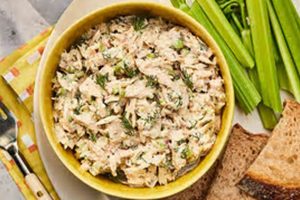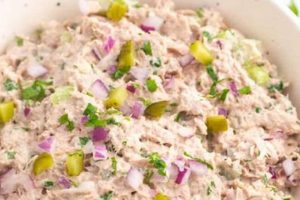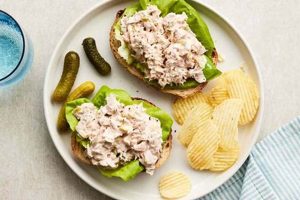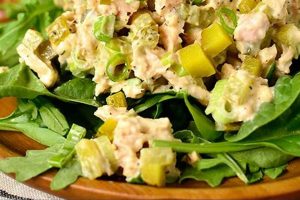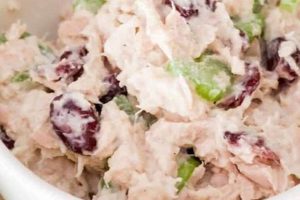A dish featuring canned tuna and cannellini beans (also known as white kidney beans) combined with other ingredients to create a flavorful, protein-rich salad. Common additions include chopped vegetables like celery, red onion, or bell pepper, fresh herbs such as parsley or dill, and a dressing typically made with olive oil, lemon juice, or vinegar. Variations might incorporate other ingredients like olives, capers, or hard-boiled eggs.
This type of salad offers a nutritious and convenient meal option. The combination of legumes and fish provides a complete protein source, essential for muscle building and repair. It is also a good source of fiber, contributing to digestive health and satiety. Furthermore, the dish is generally low in calories and fat, making it a suitable choice for those seeking a healthy and light meal. Its simple preparation and adaptability to various ingredients contribute to its enduring popularity as a quick lunch, light dinner, or picnic fare.
The following sections will delve into specific ingredient selections, preparation methods, nutritional information, and variations on this classic dish to provide a comprehensive guide to creating and enjoying a delicious and healthful meal.
Tips for a Superior Cannellini Bean and Tuna Salad
Elevating this simple dish to culinary excellence involves attention to detail and thoughtful ingredient selection. The following tips provide guidance for creating a truly exceptional salad.
Tip 1: Bean Quality Matters: Opt for high-quality canned cannellini beans, rinsed thoroughly to remove excess starch and sodium. Alternatively, cooking dried beans from scratch offers superior flavor and texture control.
Tip 2: Tuna Selection: Select tuna packed in water or olive oil, avoiding oil-packed varieties with added flavorings that can overpower the delicate bean flavor. Solid or chunk light tuna generally works best.
Tip 3: Freshness is Key: Utilizing fresh, crisp vegetables significantly enhances the salad’s flavor and texture. Finely dice vegetables for optimal distribution throughout the salad.
Tip 4: Herb Integration: Fresh herbs provide a burst of flavor. Parsley, dill, and chives are excellent choices, finely chopped to prevent overpowering the other ingredients.
Tip 5: Dressing Dynamics: A simple vinaigrette of extra virgin olive oil and lemon juice or red wine vinegar provides a bright, acidic counterpoint to the richness of the tuna and beans. Experiment with Dijon mustard, minced garlic, or a touch of honey for added complexity.
Tip 6: Seasoning Strategies: Salt and freshly ground black pepper are essential. A pinch of red pepper flakes adds a subtle heat, while a dash of smoked paprika enhances the overall flavor profile.
Tip 7: Chilling Time: Allowing the salad to chill for at least 30 minutes before serving allows the flavors to meld and enhances the overall experience.
By following these tips, one can transform a basic combination of ingredients into a truly remarkable culinary creation, maximizing flavor, texture, and nutritional value.
The following section will offer variations and serving suggestions to further inspire culinary exploration with this versatile and satisfying dish.
1. High-Quality Ingredients
High-quality ingredients are foundational to a superior cannellini bean and tuna salad. Ingredient quality directly impacts the final dish’s flavor, texture, and overall nutritional value. Choosing superior components elevates this simple salad from ordinary to exceptional.
For instance, using canned tuna packed in olive oil rather than a lower-quality oil or water significantly enhances the salad’s richness and depth of flavor. Similarly, opting for firm, fresh vegetables like crisp celery and vibrant red onion contributes a satisfying textural element often lacking with less-fresh produce. Selecting premium cannellini beans, either canned or cooked from dried, ensures a creamy texture and optimal flavor, avoiding mushiness or off-flavors sometimes associated with lower-quality beans. Even seemingly minor ingredients, such as the olive oil used in the dressing, contribute significantly to the overall quality; extra virgin olive oil provides a more complex and nuanced flavor than standard olive oil. Furthermore, using fresh herbs instead of dried counterparts delivers a brighter, more vibrant flavor profile.
The cumulative effect of selecting high-quality ingredients is undeniable. The resulting salad boasts a more robust, well-rounded flavor profile, a pleasant and varied texture, and maximized nutritional benefits. While cost considerations sometimes factor into ingredient choices, prioritizing quality whenever possible consistently yields a more satisfying culinary experience. Understanding this connection empowers one to make informed decisions, ultimately leading to a more enjoyable and healthful meal.
2. Proper Bean Preparation
Proper bean preparation is crucial for a successful cannellini bean and tuna salad. It significantly impacts the texture, flavor, and overall enjoyment of the dish. Improperly prepared beans can result in a mushy texture or undesirable flavors that detract from the salad’s overall quality.
- Rinsing Canned Beans
Thoroughly rinsing canned cannellini beans removes excess starch and sodium, contributing to a cleaner flavor profile and preventing a gummy texture. This step is essential for achieving a pleasant mouthfeel and allowing the other salad ingredients to shine.
- Cooking Dried Beans
Using dried cannellini beans offers superior flavor and texture control but requires proper cooking techniques. Soaking the beans overnight helps reduce cooking time and ensures even cooking. The beans should be cooked until tender but not mushy, maintaining their shape while offering a creamy interior.
- Draining and Drying
After cooking or rinsing, the beans must be thoroughly drained and, ideally, patted dry. Excess moisture can dilute the salad dressing and lead to a watery final product. This step is particularly important when using canned beans, as the canning liquid can impart unwanted flavors.
- Timing of Bean Addition
Adding the beans to the salad at the correct time is crucial. If added too early, they can absorb too much dressing and become overly soft. Adding them just before serving helps maintain their desired texture and prevents them from dominating the other ingredients.
By adhering to these proper bean preparation techniques, one ensures the cannellini beans contribute positively to the salad’s overall appeal. The result is a dish with a harmonious balance of flavors and textures, where the beans complement the other ingredients without overpowering them. Attention to this seemingly minor detail significantly elevates the final culinary outcome.
3. Flavorful Tuna Selection
Flavorful tuna selection significantly impacts the overall quality of a cannellini bean and tuna salad recipe. Tuna, as a primary ingredient, contributes substantially to the final dish’s taste profile. Careful consideration of tuna variety, packing medium, and quality ensures a balanced and enjoyable culinary experience. Choosing tuna packed in olive oil adds richness and depth, while water-packed tuna offers a leaner, cleaner flavor. Oil-packed tuna with added herbs or spices can complement the other salad ingredients, but may also overpower more delicate flavors. High-quality tuna, characterized by a firm texture and clean taste, enhances the salad’s overall appeal. Conversely, lower-quality tuna can introduce undesirable fishy flavors or a mushy texture, detracting from the desired outcome.
For example, using premium albacore tuna packed in olive oil creates a richer, more luxurious salad, while chunk light tuna in water offers a lighter, more budget-friendly option. Aligning tuna selection with desired flavor profiles allows for customization and optimization of the recipe. Consideration should also be given to the other salad ingredients. A robust, oil-packed tuna might overwhelm a salad with delicate herbs and a light vinaigrette, whereas a milder tuna allows these subtleties to shine. Matching the tuna’s intensity to the other components creates a harmonious balance.
Ultimately, thoughtful tuna selection elevates the cannellini bean and tuna salad from a simple combination of ingredients to a well-balanced, flavorful dish. Understanding the nuances of tuna varieties and packing mediums empowers one to make informed decisions, contributing to a more satisfying culinary result. This careful attention to a key ingredient demonstrates a commitment to quality and significantly impacts the overall dining experience.
4. Complementary Vegetables
Complementary vegetables play a vital role in enhancing the flavor, texture, and nutritional value of a cannellini bean and tuna salad. These vegetables contribute not only textural contrast but also a broader spectrum of nutrients and flavors, transforming a simple protein-based salad into a more complex and satisfying meal. Careful selection ensures a balanced and harmonious blend of ingredients, maximizing the dish’s overall appeal.
The choice of vegetables directly impacts the salad’s sensory experience. Crisp vegetables like celery and red onion offer a refreshing crunch, contrasting with the creamy texture of the beans and tuna. Bell peppers introduce a subtle sweetness and vibrant color, while chopped cucumbers contribute a cool, hydrating element. The interplay of these textures and flavors creates a more dynamic and engaging culinary experience. Furthermore, incorporating a variety of vegetables broadens the nutritional profile, adding essential vitamins, minerals, and dietary fiber. For example, red onion provides antioxidants, while bell peppers are rich in vitamin C. This nutritional diversity contributes to a more healthful and well-rounded meal.
Optimal selection hinges on achieving a balance of flavors and textures that complement the core ingredients. Overly strong-flavored vegetables, such as raw garlic or certain cruciferous vegetables, might overpower the delicate flavors of the beans and tuna. Conversely, bland vegetables might fail to provide sufficient contrast, resulting in a monotonous culinary experience. Thoughtful consideration of flavor profiles and textural contributions ensures a harmonious and satisfying final product, maximizing both taste and nutritional value. This understanding facilitates informed ingredient selection, elevating the cannellini bean and tuna salad from basic sustenance to a truly enjoyable culinary creation.
5. Balanced Dressing
A balanced dressing is essential for a successful cannellini bean and tuna salad recipe. The dressing serves not merely as a coating but as a unifying element, harmonizing the flavors and textures of the various components. It provides essential acidity, richness, and seasoning, transforming individual ingredients into a cohesive and flavorful dish. A well-balanced dressing elevates the salad beyond a simple combination of components, creating a more nuanced and satisfying culinary experience.
- Acidity
Acidity, often provided by lemon juice, vinegar, or a combination thereof, is crucial for balancing the richness of the tuna and beans. It brightens the overall flavor profile, cutting through the fattiness of the fish and preventing the salad from feeling heavy or overly rich. The right level of acidity also enhances the other flavors, making them more pronounced and distinct. For example, a lemon vinaigrette adds a refreshing zest, while red wine vinegar contributes a subtle tang.
- Richness
Richness, typically derived from olive oil, complements the acidity and contributes to a more luxurious mouthfeel. The oil coats the ingredients, binding them together and creating a more cohesive texture. It also carries and distributes the flavors of the other dressing components throughout the salad. High-quality extra virgin olive oil adds its own distinct flavor profile, further enhancing the overall complexity of the dish.
- Seasoning
Proper seasoning enhances the flavors of all the ingredients. Salt and freshly ground black pepper are essential, providing baseline savory notes. Additional seasonings, such as Dijon mustard, minced garlic, or herbs, introduce further complexity and depth. The balance of seasoning should complement, not overpower, the inherent flavors of the tuna, beans, and vegetables. For example, a touch of Dijon mustard adds a subtle tang, while a pinch of red pepper flakes introduces a hint of heat.
- Emulsification
A stable emulsion, achieved by whisking or blending the dressing ingredients thoroughly, ensures a smooth and consistent texture. Emulsification prevents the oil and acidic components from separating, providing a uniform coating for the salad ingredients and preventing a greasy or watery mouthfeel. A stable emulsion also contributes to a more visually appealing presentation.
These facets of a balanced dressing work synergistically to create a cannellini bean and tuna salad that is both flavorful and harmonious. The interplay of acidity, richness, and seasoning elevates the individual ingredients, creating a cohesive and satisfying culinary composition. A well-executed dressing transforms the salad from a simple combination of components into a carefully crafted dish, highlighting the importance of this often-overlooked element.
6. Seasoning Techniques
Seasoning techniques significantly influence the final flavor profile of a cannellini bean and tuna salad. Beyond simply adding salt and pepper, strategic seasoning elevates the dish from palatable to exceptional. Understanding the interplay of seasonings allows for a nuanced approach, enhancing the inherent flavors of the core ingredients while adding depth and complexity. This involves careful consideration of seasoning types, quantities, and application timing.
For instance, freshly ground black pepper adds a subtle heat and enhances the savory notes of the tuna. A pinch of red pepper flakes introduces a touch of spice, while a hint of smoked paprika contributes a smoky depth. Fresh herbs, such as dill or parsley, provide brightness and freshness. The quantity of each seasoning is crucial; an overabundance can mask the delicate flavors of the beans and tuna, while too little fails to enhance the overall taste. Furthermore, the timing of seasoning application affects the final outcome. Salt added too early can draw moisture from the vegetables, resulting in a watery salad. Seasoning the dressing separately allows for better flavor distribution throughout the dish.
Mastery of seasoning techniques allows for customization and optimization of the recipe. Understanding the interplay of flavors empowers one to create a salad tailored to specific palates. It also enables adjustments based on ingredient variations. For example, a salad with bolder ingredients, such as olives or capers, might require more assertive seasoning than one with milder components. Ultimately, proper seasoning transforms a simple cannellini bean and tuna salad into a complex and flavorful culinary creation, highlighting the importance of this often underestimated aspect of recipe development.
7. Chilling and Serving
Chilling and serving are crucial final steps in preparing a cannellini bean and tuna salad recipe. Chilling allows the flavors of the various componentsthe tuna, beans, vegetables, and dressingto meld and deepen. This enhances the overall complexity and balance of the final dish. The low temperature also firms the vegetables, maintaining desirable texture and preventing them from becoming soggy. Chilling time influences flavor development; a brief chill maintains the brightness of individual ingredients, while extended chilling creates a more integrated flavor profile.
Serving methods significantly impact presentation and enjoyment. Traditional presentation involves serving the salad chilled on a bed of lettuce or greens, garnished with fresh herbs or a sprinkle of paprika. Alternatively, it can be served as a sandwich filling, providing a protein-rich and flavorful lunch or light meal option. Scoops of the salad can accompany crackers or crusty bread for a lighter approach. For larger gatherings, it can be presented as a layered salad in a clear bowl, showcasing the vibrant colors and textures. The choice of serving method depends on the occasion and desired aesthetic.
Proper chilling and thoughtful serving elevate the cannellini bean and tuna salad from a simple mixture to a carefully considered culinary experience. Chilling enhances flavor development and textural integrity, while serving methods impact presentation and enjoyment. Attention to these seemingly minor details demonstrates a commitment to quality and maximizes the potential of this versatile dish.
Frequently Asked Questions
This section addresses common inquiries regarding cannellini bean and tuna salad preparation and variations.
Question 1: What is the best type of tuna to use?
High-quality canned tuna packed in either water or olive oil is recommended. Solid or chunk light tuna generally provides the best texture. Oil-packed tuna adds richness, while water-packed offers a leaner option.
Question 2: Can dried cannellini beans be used instead of canned?
Dried beans offer superior flavor and texture but require pre-soaking and cooking. Soak beans overnight and then cook until tender but not mushy.
Question 3: How long can the salad be stored in the refrigerator?
Properly stored in an airtight container, the salad should last for up to 3-4 days in the refrigerator. Consume within this timeframe for optimal quality and food safety.
Question 4: What are some healthy variations on the classic recipe?
Substituting Greek yogurt for some or all of the mayonnaise reduces fat and calories. Adding different vegetables, such as chopped bell peppers or cucumbers, increases nutritional value and provides textural variety. Incorporating whole grains, like quinoa or farro, adds fiber and complex carbohydrates.
Question 5: Can this salad be frozen?
Freezing is not recommended. Mayonnaise-based dressings tend to separate upon thawing, resulting in an undesirable texture. Vegetables also lose their crispness when frozen and thawed.
Question 6: What can be served with cannellini bean and tuna salad?
The salad can be served on a bed of lettuce, as a sandwich filling, or with crackers or crusty bread. It also complements a variety of side dishes, such as roasted vegetables, a simple green salad, or a fruit salad.
Careful attention to ingredient selection, preparation, and storage ensures a safe and delicious culinary experience.
The following section provides a sample recipe incorporating the information discussed.
Cannellini Bean and Tuna Salad Recipe
Exploration of the cannellini bean and tuna salad recipe reveals its potential beyond a simple combination of ingredients. Careful consideration of bean preparation, tuna selection, complementary vegetables, balanced dressing, and seasoning techniques elevates this dish to a flavorful and nutritious meal. Proper chilling and serving methods further enhance the sensory experience. Understanding these aspects allows for customization and optimization, catering to individual preferences and dietary needs.
This exploration underscores the significance of thoughtful ingredient selection and preparation in maximizing culinary potential. Application of these principles transcends this specific recipe, offering a framework for approaching any culinary endeavor with intention and creativity. One is encouraged to explore variations and personalize the recipe, furthering appreciation for the versatility and nutritional value offered by this classic combination.

